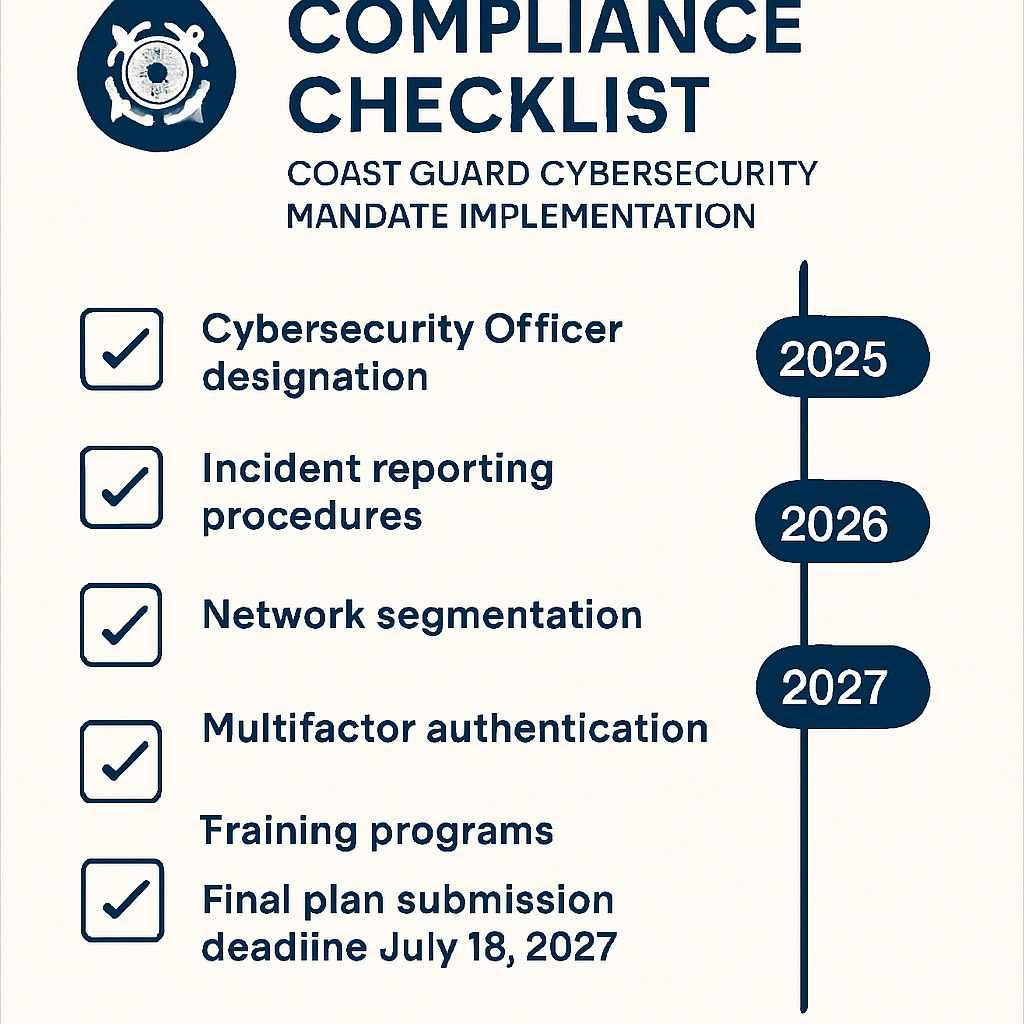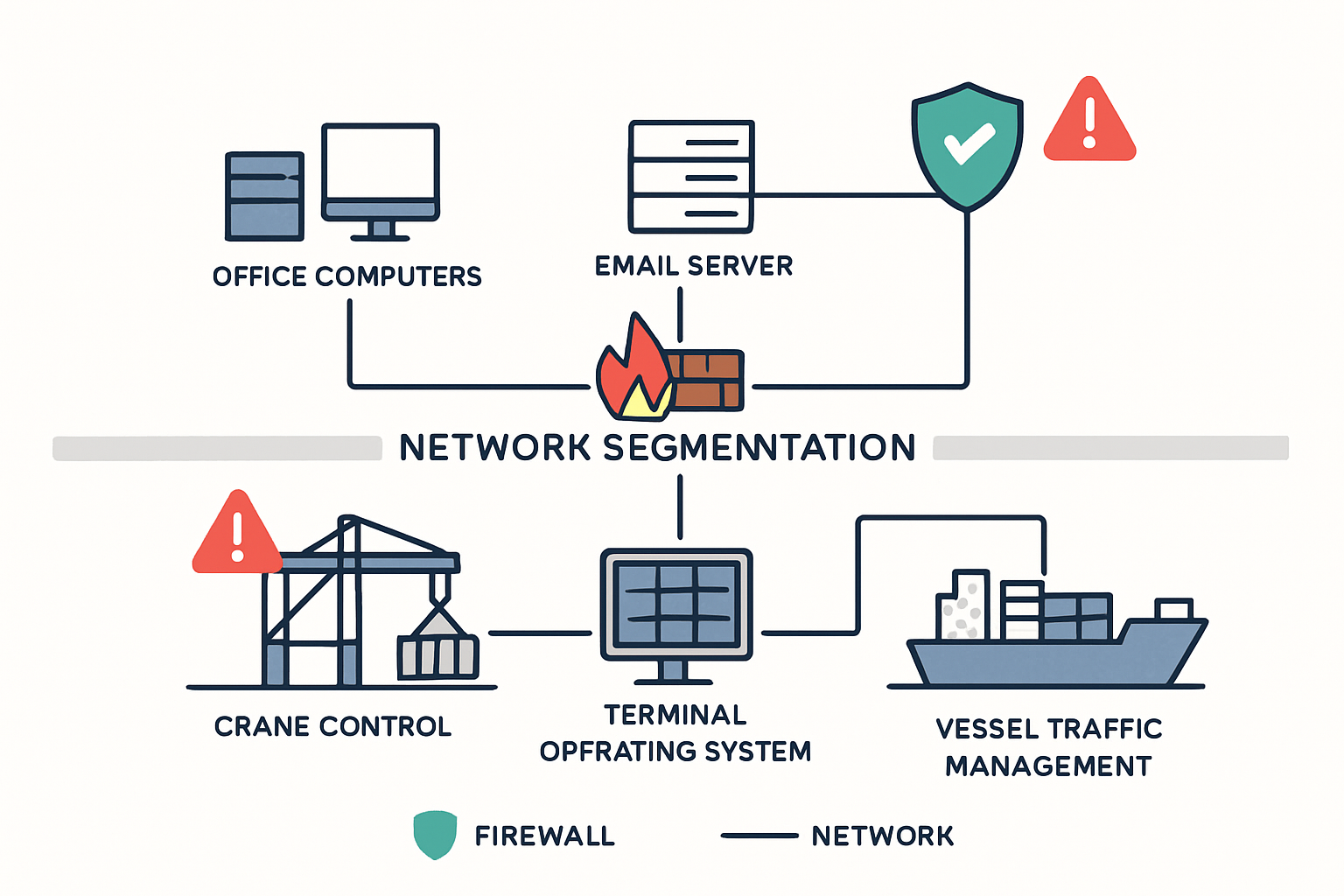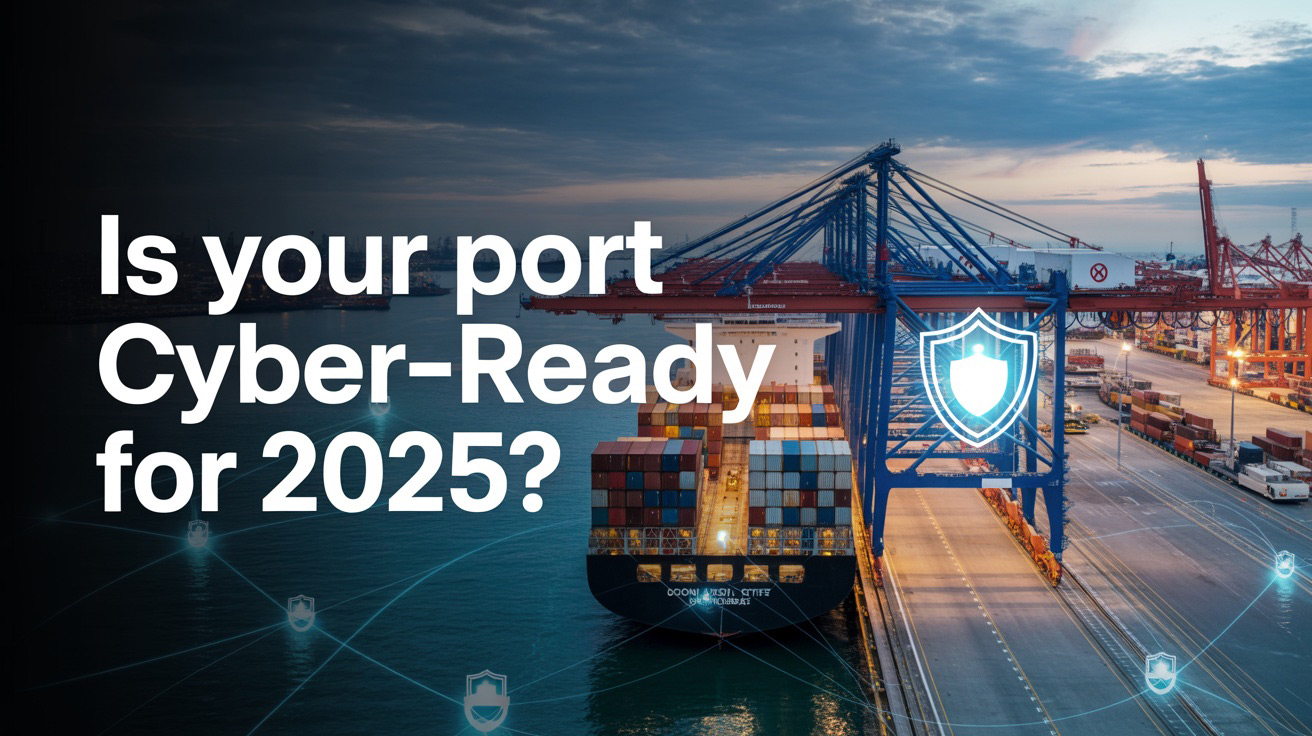When Digital Pirates Target Your Fleet: The New Reality of Maritime Cybersecurity
Imagine this scenario: It’s 3 AM on a Tuesday. Your container terminal’s crane operations suddenly freeze mid-lift. Twenty-foot containers hang suspended over million-dollar vessels. Your IT team scrambles to understand what’s happening.
The culprit? A sophisticated ransomware attack that infiltrated your operational technology systems through a seemingly innocent email attachment.
Within hours, your entire port operation grinds to a halt. The cost? Thousands of dollars per minute in delays. The risk? Compromised safety for your crew and cargo.
This Isn’t Science Fiction—It’s Today’s Maritime Reality
This scenario represents the stark reality facing maritime operators in 2025. Consider these alarming facts:
- 80% of ship-to-shore cranes at U.S. ports are manufactured by Chinese companies
- Remote operation capabilities create massive attack surfaces for digital threats
- State-sponsored Advanced Persistent Threat groups are escalating campaigns against critical infrastructure
- Maritime operations rank as prime targets for cybercriminals
The convergence of Information Technology (IT) and Operational Technology (OT) systems promised unprecedented efficiency. Instead, it created a perfect storm of vulnerability.
The Coast Guard’s Response: Comprehensive Cybersecurity Regulation
The U.S. Coast Guard recognizes this clear and present danger. On January 17, 2025, they published the most comprehensive maritime cybersecurity regulation in history. This final rule fundamentally transforms how port operators and vessel owners must approach digital security.
Key dates to remember: – Effective date: July 16, 2025 (already in effect) – Plan submission deadline: July 16, 2027 – Immediate requirement: Cyber incident reporting
For maritime leaders, this isn’t merely another compliance checkbox. It’s a mandate that could determine whether your operation survives the next cyber tempest or becomes another casualty in the digital seas.
Understanding the Mandate’s Scope
The Coast Guard’s final rule on “Cybersecurity in the Marine Transportation System” represents a seismic shift in maritime regulation, extending far beyond traditional physical security measures into digital protection.
Who Must Comply: The Regulated Entities
U.S.-Flagged Vessels (33 CFR Part 104): – Cargo vessels over 100 gross tons – Passenger vessels certified for more than 150 passengers – Offshore Supply Vessels and Mobile Offshore Drilling Units
Port Facilities (33 CFR Part 105): – Container terminals – Chemical and petroleum facilities – Cruise ship terminals – LNG/LPG terminals
Outer Continental Shelf Facilities (33 CFR Part 106): – Oil and gas production platforms – Drilling rigs – Offshore wind energy infrastructure

Foundation Requirements: What Every Operator Must Implement
The mandate introduces several foundational requirements that will reshape maritime security operations:
✓ Qualified Cybersecurity Officer (CySO) – Available 24/7
✓ Comprehensive Cybersecurity Plans – Based on detailed assessments
✓ Separate Cyber Incident Response Plans – Tested and validated
✓ Mandatory reporting procedures – For cyber incidents
✓ Rigorous training and exercise programs – Annual requirements
These aren’t suggestions—they’re regulatory requirements with firm deadlines and serious consequences for non-compliance.
Real-World Maritime Cyber Incidents: Lessons from the Digital Deep
The urgency behind the Coast Guard’s mandate becomes crystal clear when examining recent maritime cyber incidents that demonstrate how digital vulnerabilities translate into physical consequences.
The Maersk Catastrophe: When NotPetya Struck
Year: 2017
Target: Maersk (world’s largest container shipping company)
Impact: Digital tsunami that changed everything
The NotPetya ransomware attack spread through Maersk’s global network within minutes. The result was devastating:
- 76 port terminals worldwide shut down
- 10 days of “manual mode” operations
- $300 million in losses
- Weeks of recovery efforts
This incident revealed how a single point of failure in IT systems could paralyze an entire maritime operation.
MARSEC Directive 105-5: The Chinese Crane Concern
Perhaps most concerning for U.S. port operators is the Coast Guard’s issuance of MARSEC Directive 105-5 in late 2024, specifically addressing cyber risks associated with Chinese-manufactured ship-to-shore cranes.
Key facts: – 80% of STS cranes at U.S. ports are of Chinese origin – Designed for remote operation and servicing – Additional cybersecurity requirements imposed – Direct acknowledgment of national security risk
Navigating the IT/OT Convergence Challenge
The most complex challenge facing maritime operators lies at the intersection of Information Technology and Operational Technology. This convergence has created unprecedented efficiency gains while simultaneously opening new attack vectors.

Understanding the Convergence Challenge
Traditional maritime operations relied on isolated, proprietary systems designed for reliability and safety, not connectivity. Modern maritime operations have increasingly connected these OT systems to corporate IT networks, creating pathways for cyber threats to migrate from office computers to systems that control physical operations.
Real-World Example: Container Terminal Vulnerability
Consider a modern container terminal where the same network infrastructure handles: – Email and administrative functions – Automated crane controls – Terminal operating systems – Vessel traffic management systems
The risk: A malware infection that begins in a finance department computer can potentially spread to crane control systems, creating safety hazards and operational disruptions.
Network Segmentation: Critical Defense Strategy
Network segmentation has emerged as a critical defense strategy, creating digital barriers between IT and OT systems while maintaining operational connectivity.
Coast Guard requirement: Network segmentation with logging and monitoring of all connections between segmented networks.
Best Practices for Maritime Cybersecurity Compliance
Successfully navigating the Coast Guard’s cybersecurity mandate requires robust security strategies that protect operations while enabling necessary connectivity.
Foundation: Comprehensive Asset Inventory and Risk Assessment
The foundation begins with complete visibility into all IT and OT systems:
Essential inventory components: – All hardware, firmware, and software – System connections and data flows – Operational functions supported – Legacy equipment often overlooked
Identity and Access Management: Critical Requirements
The Coast Guard’s mandate for multifactor authentication applies to: – All password-protected IT systems – All remotely accessible OT systems
Implementation considerations: – Must work reliably in challenging connectivity environments – Cannot interfere with emergency response procedures – Requires backup authentication methods
Incident Response: Mission-Critical Planning
Incident response planning becomes particularly critical in maritime environments where cyber incidents can create safety risks, environmental damage, and significant economic losses.
Effective incident response plans must address: – Threat containment procedures – System isolation protocols – Maintaining safe maritime operations – Communication protocols with Coast Guard
Your Trusted Navigator: How The Saturn Partners Guides Maritime Compliance
As maritime operators face the complex challenge of implementing comprehensive cybersecurity programs under tight regulatory deadlines, specialized expertise becomes invaluable.
The Saturn Partners brings over two decades of cybersecurity excellence and regulatory compliance expertise to help maritime organizations navigate these turbulent digital waters.
Our Foundation: Excellence Since 2001
Founded in 2001 by Carole Crawford, The Saturn Partners has built its reputation on a consultative approach that goes far beyond commodity cybersecurity services. Our deep experience in heavily regulated industries provides the regulatory expertise that maritime operators need.
Virtual Chief Information Security Officer (vCISO): Meeting Coast Guard Requirements
Our vCISO service directly addresses one of the Coast Guard mandate’s most critical requirements—the designation of a qualified Cybersecurity Officer.
Benefits over full-time hiring: – Significant cost savings – CISSP-certified experts – Extensive regulatory compliance experience – Immediate availability
24/7 Security Operations Center (SOC): Continuous Maritime Protection
The 24/7 SOC service provides the continuous monitoring capability that maritime operations demand across global time zones.
Our SOC delivers: – Real-time threat detection by certified experts – Cloud-based deployment (no hardware investment) – Guaranteed Service Level Agreements – Customized dashboards for full visibility
Cybersecurity as a Service (SECaaS): Comprehensive Technical Controls
Our SECaaS offering provides the technical controls required by the Coast Guard mandate through a single, integrated platform:
Included services: – Data and email encryption – Cloud environment security – Mobile device management – Endpoint detection and response – Security Information and Event Management (SIEM)
Backup & Disaster Recovery: Rapid Maritime Recovery
Our Backup & Disaster Recovery service addresses Coast Guard requirements while providing rapid recovery capabilities:
Key features: – Guaranteed 30-minute restoration for virtual environments – Data encryption in transit and at rest – Continuous integrity monitoring – Protection and reliability for maritime operations
Setting Course for Secure Operations: Your Next Steps
The Coast Guard’s 2025 cybersecurity mandate represents more than a regulatory requirement—it’s a fundamental transformation in how maritime operations must approach digital security.
Critical Timeline Awareness
Immediate requirements: – Cyber incident reporting (already in effect) – Cybersecurity Officer designation – Basic security measures implementation
Approaching deadlines: – July 16, 2027: Cybersecurity Plan submission – Ongoing: Training and exercise requirements
The Strategic Advantage of Proactive Compliance
Organizations that embrace this challenge proactively will not only achieve regulatory compliance but will build competitive advantages:
✓ Enhanced operational resilience
✓ Improved risk management
✓ Stronger stakeholder confidence
✓ Reduced insurance costs
Take Action Today: Secure Your Maritime Future
Don’t let your maritime operation become another casualty in the rising tide of cyber threats.
Contact Saturn Partners today to begin your journey toward comprehensive cybersecurity compliance and operational resilience.
Our team of CISSP-certified experts is ready to serve as your trusted navigator through the complex waters of maritime cybersecurity regulation.
Schedule your comprehensive cybersecurity assessment
The tide waits for no one—but with Saturn Partners as your guide, you’ll be ready for whatever digital storms lie ahead.

